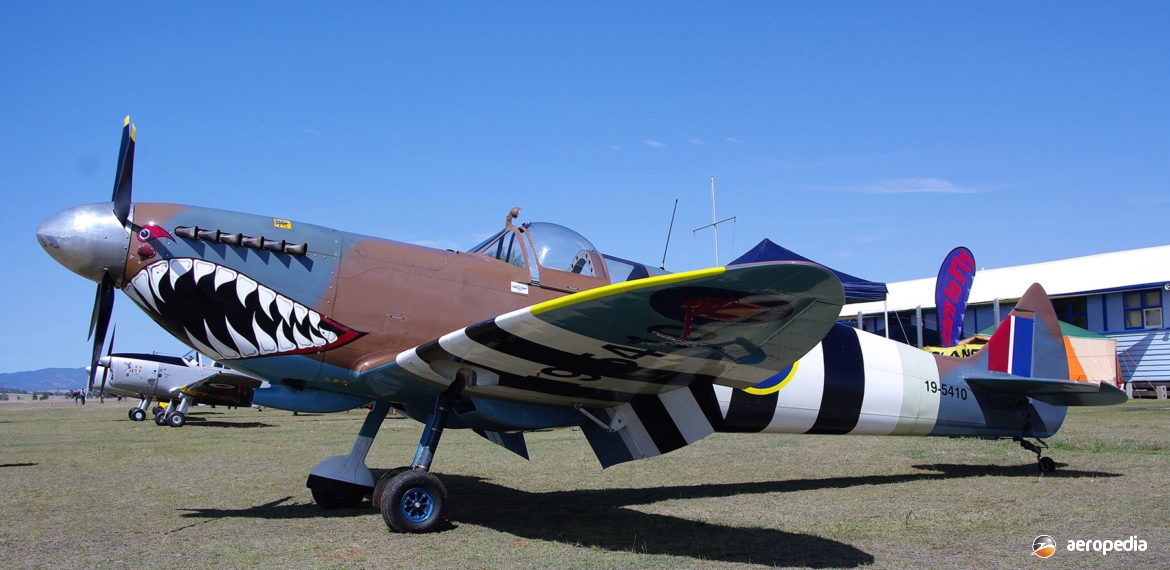Photograph:
Supermarine Aircraft Factory Spitfire 26 19-5410 (c/n 068) at Watts Bridge, QLD in August 2010 (David C Eyre)
Country of origin:
Australia
Description:
Two-seat light sport aircraft
Power Plant:
(Mk 26B)
One 134 kw (180 hp) Jabiru 5100 eight-cylinder horizontally-opposed air-cooled engine
Specifications:
- Wingspan: 8.42 m (27 ft 8¼ in)
- Length: 7.3 m (23 ft 7¾ in)
- Height: 2.1 m (6 ft 9 in)
- Wing area: 11.33 m² (122 sq ft)
- Max cruising speed at 75% power: 296 km/h (184 mph)
- Economical cruising speed: 278 km/h (173 mph)
- Stalling speed flaps down: 77 km/h (48 mph)
- Max rate of climb at sea level: 762 m/min (2,500 ft/min)
- Service ceiling: 5,490 m (18,000 ft)
- Take-off run: 297 m (679 ft)
- Landing run: 445 m (1,460 ft)
- Range: 804 km (500 miles)
- Endurance at economical cruising speed with reserves: 3 hours
- G limits: +6/-4 G
- Empty weight: 450 kg (992 lb)
- Loaded weight: 810 kg (1,785 lb)
History:
The 2/3 Spitfire, as it was initially known,was produced by the Supermarine Aircraft Factory at Archerfield, QLD and was a fairly new foray into producing scale replicas of well known warbirds in Australasia. This area of sport flying has become popular in recent years, due to the high cost of owning and maintaining full scale warbirds. Examples of the North American Mustang, Curtiss Kittyhawk, Hawker Hurricane, Focke Wulf FW-190, Messerschmitt Bf 109, Fieseler Storch, etc have been produced in kit form to various scales, and completed and flown in recent years.
Introduced to the market in 1997, the prototype Spitfire was two-thirds scale, was a single-seater, and was of all-metal construction. The concept of the design was commenced in 1994 and construction of the prototype began in 1996, the first flight being made on 8 February 1997. The type was publicly displayed at the 1999 Australian International Airshow at Avalon, VIC and was advertised as being available in kit form. Initially engines in the 56 kw (75 hp) to 86 kw (115 hp) range could be installed and the popular Australian-designed and built Jabiru four-cylinder unit was usually installed, early examples having the 60 kw (80 hp) 2200 cc unit, but later models having the 75 kw (100 hp) 3300 cc unit, the latter permitting the installation of 12 individual exhaust stubs.
Development of the type continued, the second model being the Mk 25, a 75% scale replica of the Spitfire Mk V with a retractable undercarriage and a Jabiru 3300 cc engine. Later the design was enlarged to 80% and became the Mk 26. Some fairings and parts of the engine cowling were built from fibreglass, and it had more power.
Changes from aircraft serial No 017 included installation of the new Jabiru eight-cylinder Model 5100 (5,500 cc) horizontally-opposed engine in what became known as the Mk 26B, this engine providing 134 kw (180 hp) at 3,000 rpm, driving a four-blade propeller, having a retractable undercarriage and flaps. However, this engine, because of the reduction drive unit, suffered some overheating and Rotec Australia developed and produced replacement liquid-cooled cylinder heads for the engine. During testing of the earlier variants of the engine this model achieved 407 km/ h (253 mph) at 3,048 m (10,000 ft), a cruising speed at sea level of 287 km/h (178 mph), and a rate of climb of 762 m/min (2,500 ft/min).
This model was sold in kit form or as a complete ready-to-fly aircraft, and examples were exported to the United Kingdom, the United States, Ireland and Canada. The airframe was tested to 9G and was rated at +6/-3G. Fuel capacity was 95 litres (21 Imp gals). The aircraft seated two, had a retractable undercarriage and four Fowler flaps. The wings could be removed for towing or storage.
A variety of engines has been installed in the series, including a 350 cubic inch converted Chevrolet V-8 engine; and the 198 kw (266 hp) at 4,800 rpm Isuzu aluminium block quad-cam fuel-injected V-6 liquid-cooled unit providing 168 kw (226 hp) driving an Ivoprop. This engine was produced in two forms: normally aspirated, and the supercharged version which produced 231 kw (310 hp). It could be fitted with two, three or four-blade propellers. Fuel capacity was increased to 115 litres (25 Imp gals), and subsequently wet wings were designed, with a 75 litre (16.5 Imp gal) tank in each wing.
The aircraft was subsequently produced in two models, the Mk 26, which was an 80% scale Spitfire, and the Mk 26B, which was 90% scale and was a stretched model, being 35.5 cm (14 in) longer and 12.7 cm (5 in) wider than the previous model, and having a wider and deeper cockpit. Tests of the Mk 26B revealed a stalling speed of 78 km/h (48 mph) in landing configuration, and 89 km/h (55 mph) clean. With the roomier cockpit there was adequate room for two adults and a second control stick could be installed.
This model was the subject of a weight saving programme, was later fitted with an Isuzu six-cylinder VEE engine with a belt-driven supercharger with a MoTeC engine management system, and was produced in two versions as noted above. The prototype Mk 26B first flew on 22 March 2007. Eventually the Company moved the production of replica scale Spitfires to Cisco in Texas, USA where production of kits continued.
By early 2018 five examples appeared on the New Zealand Register, one of these being imported from the United Kingdom where it operated as G-CENI, becoming ZK-EFY² and being fitted with an eight-cylinder Jabiru 5100A direct drive engine. A number appear on the Australian Civil Aircraft Register, and others are registered with the RAA.

